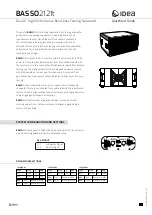
1 Connections and
Control Elements
1
Signal inputs IN-1/IN-2 (XLR) to con-
nect a signal source with line level;
parallel outputs PARALLEL OUT to
route the signal to another amplifier
system, for example
2
Status LEDs
SIG
input signal
−24/−6/0 dB output level
CLIP
overload;
will flash slowly for muted
inputs
3
Button MENU to call up the setting
menu and to terminate the entry of a
name or password
4
Button ESC to cancel an entry and to
exit the setting menu or a submenu
5
LC display
6
RJ45 jack for the Ethernet connection
to configure the signal processor by
means of a computer
7
USB jack (type B) to configure the sig-
nal processor by means of a computer
8
Rotary knob SELECT/ENTER to se-
lect and change settings; to confirm a
selection or setting, press the knob
9
Signal outputs OUT-2/OUT-3 for sig-
nals (XLR, line level) processed with
the DSP
10
POWER switch
11
Support for the mains fuse
Always replace a blown fuse by one of
the same type.
12
Powercon
®
mains jack for connection
to a socket (230 V~/50 Hz) via the
mains cable provided
2 Safety Notes
The unit corresponds to all relevant direc-
tives of the EU and is therefore marked
with
.
G
The unit is suitable for indoor use only.
Protect it against dripping water and
splash water, high air humidity and heat
(admissible ambient temperature range:
0 – 40 °C).
G
Do not place any vessel filled with liquid
on the unit, e. g. a drinking glass.
G
The heat generated inside the unit must
be dissipated by air circulation; never
cover the air vents of the housing.
G
Do not operate the unit and immediately
disconnect the mains plug from the
socket
1. if the unit or the mains cable is visibly
damaged,
2. if a defect might have occurred after
the unit was dropped or suffered a
similar accident,
3. if malfunctions occur.
In any case the unit must be repaired by
skilled personnel.
G
Never pull the mains cable to disconnect
the mains plug from the socket; always
seize the plug.
G
No guarantee claims for the unit and no
liability for any resulting personal dam-
age or material damage will be accepted
if the unit is used for other purposes than
originally intended, if it is not correctly
connected or operated or if it is not
repaired in an expert way. Likewise, no
liability will be accepted for data loss
caused by a defect or operating errors
and for any consequential damage of this
data loss.
3 Applications
This active subwoofer speaker system is
equally designed for fixed installations and
for mobile applications, e. g. on stage or in
discotheques. It is used as a low-frequency
complement to an existing amplification
system with special requirements concern-
ing low-bass reproduction. The integrated
amplifier operates with two power ampli-
fiers (class D) and provides a peak power
of 2400 W at the two 38 cm (15″) high-per-
formance speakers.
Two line level outputs provide signals that,
like the subwoofer signal for the integrated
speakers, can be processed by means of
the integrated signal processor (DSP).
Thus, the signal processor can be used as
crossover network for the subwoofer and
the rest of the PA system. Please refer to
figure 2 for an example of this unit constel-
lation. Additionally, the DSP provides
numerous signal processing options such
as various filter types, compressor, level
limitation, phase inversion and signal delay
for each input and output of the subwoofer
system. Thus, the subwoofer system can
be perfectly matched to the other speakers
used and to the acoustic situation of the
application site. All settings can be edited
at the subwoofer system or with a com-
puter connected via USB or Ethernet and
can be saved as presets in the subwoofer
system. It is also possible to control the
subwoofer system with a tablet computer.
The subwoofer system is equipped with
a temperature-controlled fan to ensure suf-
ficient cooling. Extensive protective circuits
protect both the amplifier and the speakers.
4 Setup Options
Place the subwoofer system on a solid sur-
face. Equipped with rubber feet both on its
short and long sides, the subwoofer system
can be set up in two different ways. When
a single subwoofer is used, it is not impor-
tant to place the subwoofer exactly in the
middle between the stereo speakers as it
will not be possible to precisely locate the
very low frequencies reproduced by the
subwoofer. In order to ensure sufficient
cooling of the subwoofer, air must always
be able to flow freely through the air vents.
It is possible to install another speaker
system onto the subwoofer system: The
handle recesses pointing upwards provide
M20 threads to which a spacer tube (e. g.
KM-21367) can be attached.
If the unit is to be put out of opera-
tion definitively, take it to a local
recycling plant for a disposal which
is not harmful to the environment.
WARNING
The unit uses dangerous
mains voltage. Leave servi-
cing to skilled personnel only
and do not insert anything
into the air vents. Inexpert
handling of the unit may
result in electric shock.
14
E
n
g
li
sh










































